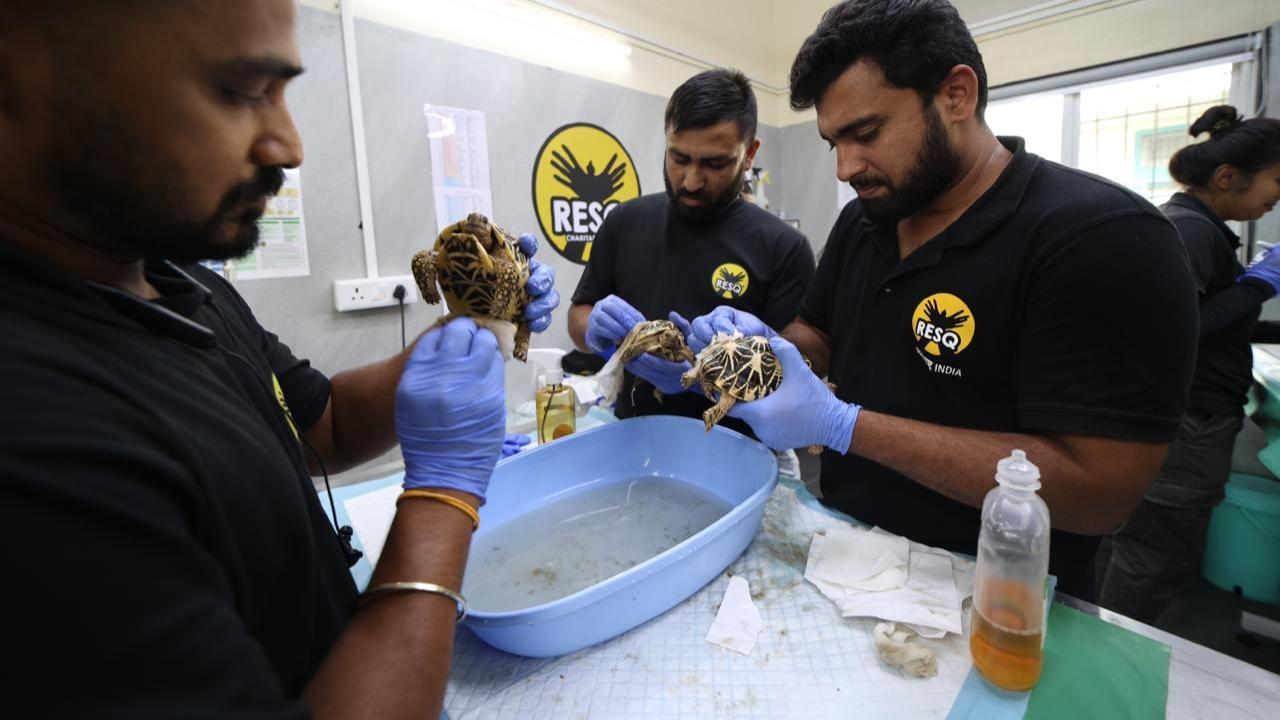
In a significant milestone for wildlife conservation, 340 Indian Star Tortoises have been successfully released into the wild at Jogapur Reserve Forest in the Rajura Forest Range of the Central Chanda Forest Division, the officials said on Saturday.
The large-scale release of Indian Star Tortoises, led by the Maharashtra Forest Department under the leadership of Vivek Khandekar, the then Chief Wildlife Warden, was conducted in collaboration with the RESQ Charitable Trust (RESQ CT) and facilitated by the Pune Wildlife Division.
The development marks one of the largest organised releases of Indian Star Tortoises in the state, following an intensive rehabilitation programme that began in late 2024. The tortoises, previously rescued from the illegal wildlife trade, have now found a new home in the reserve forests of Chandrapur, an area known for its natural habitat suitability for the species.
The Turtle Rehabilitation Project (TRP) was established to address the increasing issue of turtles and tortoises being rescued from captivity and illegal wildlife trade. With a statewide approach to their rehabilitation, the project aims to provide a systematic and sustainable solution for their return to the wild. Over the past few months, 441 Indian Star Tortoises have been admitted to the programme, many in poor health due to their previous conditions in captivity. With a survival rate of approximately 80 per cent, the current cohort ready for release has successfully completed all stages of medical care, quarantine, and environmental acclimatisation.
Organisations involved in the rescue of the animals into the TRP include OIPA, ACF & PAWS-Mumbai, Bhavans Nature and Adventure Centre, WWA India, RAWW, Thane Community for the Protection and Care of Animals, Dahanu Turtle Rescue Centre, RESQCT-Eco Echo Nashik, and RESQ Charitable Trust, Pune, which spearheaded the rehabilitation and release project. The rehabilitation was supported by generous donations and collaborative efforts with the Maharashtra Forest Department.
The rehabilitation programme, carried out at the Wildlife Transit Treatment Centre in Bavdhan, Pune, was designed to closely replicate the animals` natural living conditions. Many of the rescued tortoises had spent prolonged periods in captivity, often in substandard conditions, leading to nutritional deficiencies and health issues. Upon arrival, the tortoises were categorised based on size and sex to reduce stress and ensure appropriate care.
The rehabilitation process involved stabilisation, medical treatment, and quarantine, followed by a gradual transition to semi-natural outdoor rehabilitation habitats. The tortoises were placed on species-specific diets, focused on native grasses and seasonal vegetation, to rebuild gut health and encourage natural foraging behaviours. Special attention was also given to UV exposure and thermoregulation through basking zones and shaded resting areas. The goal was to help the tortoises regain their natural behaviours and adapt to wild conditions.
Progress was carefully tracked through biometric assessments, such as weight, shell quality, hydration levels, and behavioural observations of feeding, mobility, and social interactions. A team of dedicated wildlife rehabilitators and veterinarians provided continuous care tailored to the needs of each individual.
Encouragingly, the majority of the tortoises demonstrated significant improvements in activity levels and adaptation to wild diets, highlighting their strong potential for survival after release. The animals underwent a 900-kilometre journey from Pune to Chandrapur, where they were released into Jogapur Reserve Forest, an area that has seen successful past releases of this species.
The release operation was carried out with the enthusiastic participation of over 100 children from Adarsh Vidyalaya Rajura, symbolising the growing commitment of the younger generation towards wildlife conservation. The event was supervised by Swetha Boddu, Deputy Conservator of Forests, Central Chanda Forest Division, and Pawan Jong, Sub-Divisional Forest Officer, Rajura. Post-release monitoring will be carried out by Adesh Shendage, ACF, Suresh Yelkewad, Range Forest Officer, and local forest staff.
Dr. Clement Ben, Additional Chief Conservator of Forests, Wildlife West, Mumbai, commented, “This release reflects Maharashtra`s increasing commitment to combat illegal wildlife trafficking through long-term, sustainable rehabilitation and release programmes that return animals to their natural habitats.”
Jitendra Ramgaonkar IFS, Chief Conservator of Forests, Chandrapur, highlighted, “These releases have not only strengthened local populations but also contributed to restoring ecological balance in the region. Innovative tagging solutions are being explored to better monitor the movement and behaviour of the tortoises post-release, which will help inform future conservation strategies.”
Tushar Chavan IFS, Deputy Conservator of Forests (Wildlife), added, “The Turtle Rehabilitation Project stands as a testament to what can be achieved through science-led conservation, collaboration, and dedicated rehabilitation efforts.”
Indian Star Tortoises are vital to the ecosystems they inhabit. As herbivores, they help maintain vegetation balance by grazing on grasses and low-lying plants, contribute to seed dispersal, and aid in soil aeration through their movement. The release of these tortoises not only restores individual lives but also reinforces the ecological stability of the habitats they are reintroduced into.
During the release, the children participated in an awareness session to learn about the tortoises` vital ecological role and the dangers they face from illegal pet trade. The session concluded with a call for action, encouraging students to spread the message that these animals belong in the wild, not in homes as pets.
Neha Panchamiya, Founder and President of RESQ CT, expressed, “Indian Star Tortoises are among the most sought-after species in the illegal pet trade, suffering immensely due to the growing demand. This release is not just about returning them to the wild—it’s a celebration of their freedom. It is deeply rewarding to witness their instinctive behaviours as they explore their natural surroundings post-release. Future releases will incorporate tracking devices to monitor the tortoises` movements without hindering their natural behaviour.”












